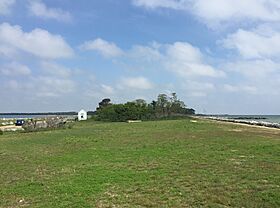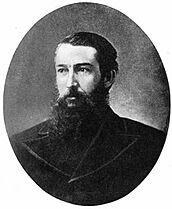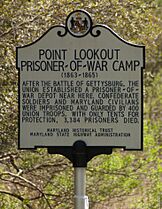Point Lookout State Park facts for kids
Quick facts for kids Point Lookout State Park |
|
|---|---|

View north from the lighthouse at Point Lookout
|
|
| Lua error in Module:Location_map at line 420: attempt to index field 'wikibase' (a nil value). | |
| Location | St. Mary's County, Maryland, United States |
| Nearest town | Lexington Park, Maryland |
| Area | 1,083 acres (438 ha) |
| Established | 1964 |
| Administered by | Maryland Department of Natural Resources |
| Designation | Maryland state park |
Point Lookout State Park is a fun place to visit in St. Mary's County, Maryland. It's at the very tip of a piece of land where the Chesapeake Bay meets the Potomac River. This park is special because it's a public recreation area and a historic site.
It protects the spot where an American Civil War prison camp once stood. You can also see the Point Lookout Light, a lighthouse built way back in 1830. Point Lookout is the southernmost point on Maryland's western shore.
Contents
Exploring Point Lookout's Early History
Captain John Smith's Visit
In 1608, a famous explorer named Captain John Smith landed at Point Lookout. He was exploring the Mid-Atlantic region for the British King. Smith explored the land and waters, including the mouth of the Potomac River. He also saw the nearby St. Mary's River.
Smith sent good reports back to the King of England. He talked about how much game and fish there were. He also mentioned the rich soil and how important the area was for military defense. It overlooked three rivers and the Chesapeake Bay. Because of all this, he thought it was a perfect spot for a new British colony.
First Settlements and Raids
The first settlement in Maryland began in 1634, close by in St. Mary's City. Point Lookout became part of St. Michael's Manor. This was a main property of Leonard Calvert, the leader of the new colony.
Later, during the American Revolution, British forces attacked Point Lookout. This was because of its important location.
Point Lookout During the War of 1812
Why is it Called Point Lookout?
The area got its name because it was used as a lookout spot. During the War of 1812, people watched for British ships from here.
The Chesapeake Bay was a key route for British warships. They set up a naval base on Tangier Island in Virginia. From there, the Royal Navy often raided towns and farms along the Chesapeake Bay. They even attacked and burned Washington, D.C. in 1814.
Secret Messages and British Invasion
During the War of 1812, local citizens formed a militia in St. Mary's County. They created a secret base at Point Lookout. Their job was to watch British warships on the Chesapeake Bay.
The militia also set up a secret system of post riders at night. These riders sent important reports from Point Lookout to Washington, D.C. This kept President James Madison updated on British movements. The roads in St. Mary's County were very rough. The trip by horse was over 80 miles. So, they used a relay system, passing messages from one rider to the next.
The citizen militia worked secretly for more than a year. But then, British forces landed and took over Point Lookout. The militia couldn't stand up to the large number of experienced British soldiers. This made it hard for American intelligence to know what the British were doing. Many believe this contributed to the Burning of Washington in August 1814.
Point Lookout During the Civil War

A Prison Camp for Soldiers
In 1862, during the American Civil War, Point Lookout changed a lot. Much of the land became a busy port and a temporary town. There were many buildings, including a large Union Army hospital. There was also a United States Army base at Fort Lincoln. Most importantly, a prison camp was built to hold captured Confederate States Army soldiers.
After the Battle of Gettysburg in July 1863, Union forces captured thousands of Confederate soldiers. Point Lookout was one of many places quickly turned into a prison camp. The camp was officially called Camp Hoffman. It was 40 acres large and located north of Hammond Hospital. A 15-foot tall wooden fence surrounded the camp. Guards watched from a platform at the top of the fence.
Life in the Camp
The Maryland Department of Natural Resources states that about 50,000 soldiers were held at Camp Hoffman. All of them lived in tents. Nearly 4,000 prisoners died there. This death rate of 8 percent was actually less than half the death rate for soldiers fighting in their own armies.
The camp was first built for 10,000 men. But it quickly grew to hold between 12,000 and 20,000 prisoners. This happened after the exchange of prisoners between armies stopped. The result was very crowded conditions. Up to sixteen men sometimes shared one tent. The sanitary conditions were also poor. It was the largest prison camp run by the Union, and it had a reputation for being one of the worst.
Remembering the Past: Memorials
The Confederate Memorial and Mass Grave
There is a mass grave at Point Lookout for 3,384 Confederate prisoners of war. These soldiers died at the prison camp. A tall pillar marks the grave. The names of the dead are carved into its base.
Next to the cemetery is the Confederate Memorial Park. This three-acre site was funded by private donations. A United States flag flies in front of the memorial. A large Confederate flag is also on a flagpole just outside the gates. It honors the Southern soldiers who died there.
Lost to the Bay
Over the last 150 years, the Chesapeake Bay shoreline has eroded a lot. Because of this, about half of the original prison camp site has been washed away by the bay.
Point Lookout State Park Today
Today, Point Lookout State Park is a great place for outdoor activities. You can still see the Point Lookout Light, the original lighthouse from 1830. The park also has a fishing pier and places to launch boats. There are public beaches, camping areas, and historical remains from the Civil War. Some people even say there are ghosts there!
Famous People Connected to Point Lookout
- Sidney Lanier, a talented poet, musician, and professor, was a Confederate prisoner of war at Point Lookout.
See also





